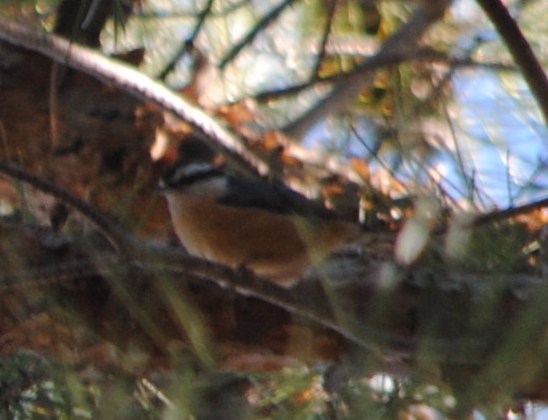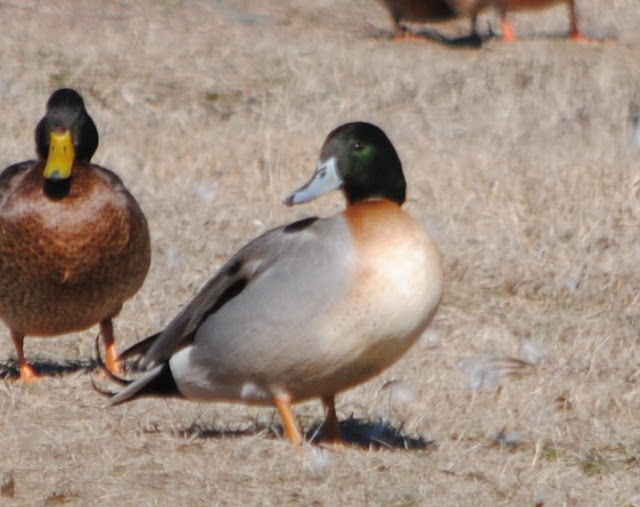Hey Readers!
This last Thursday (the 26th), Laura Ellis and
Caleb Strand picked me up on their way north on the I-17 for a day of birding in Yavapai County. It was great to be with these two again. Our first stop on the itinerary was Dead Horse Ranch State Park near the town of Cottonwood, AZ. It was a place I had never been before. With vast brushy areas and riparian stands along the Verde River, we were bound to find some interesting wildlife. At 95 for life in Yavapai County, I was destined to break 100 species today. My first three additions were Canada Geese, Common Mergansers and Canvasbacks.
I found many other Yavapai County lifers throughout the day - 33 to be exact - putting me well past 100 species!
 |
| There were many Western Bluebirds here. |
 |
| An Orange-crowned Warbler. |
 |
| A Eurasian Collared Dove |
 |
| Say's Phoebe |
 |
| An Audubon's Yellow-rumped Warbler |
In the brushy areas of the park, we encountered a variety of sparrows; principally White-crowned, Song, Lincoln's Sparrows and Dark-eyed Juncos. There was also a very clean-cut Myrtle Warbler that evaded my camera lens.
 |
| A fallax subspecies Song Sparrow |
 |
| A Lincoln's Sparrow |
 |
| This colorful Spotted Towhee was exciting to see. |

A juvenile Bald Eagle, Sharp-shinned Hawk and American Kestrel were among the raptors we encountered.
Of all the places I've birded in Yavapai County, Dead Horse Ranch seemed to have some of the best potential for rare sparrows and migrants because of the extensive cottonwood-lined river and dense brushy areas that dominated the park.
 |
| The ever-moving Brown Creeper |
 |
| An American Robin |
After birding the riparian and brushy areas quite extensively, we made the transition into more open country where we encountered American Pipits, a Vermilion Flycatcher and Oregon and Pink-sided Dark-eyed Juncos as well as good numbers of Chipping Sparrows.
 |
| An American Pipit; a plain and easily overlooked bird. |
 |
| Our only Vermilion Flycatcher at Dead Horse Ranch. |
 |
| One of 43 Chipping Sparrows we found. |
 |
| An Oregon race Dark-eyed Junco. |
 |
| This Northern Cardinal gave its typical song, but added some very odd modifications to the end... |
 |
| One of two Greater Roadrunners that were in a thicket |
 |
| The roads within the park all had bird names! |
As we were entering the park earlier in the morning, we noticed a sizable stand of non-native pines. I thought it looked great for something rare. Luckily, we decided to check it out before leaving for our next stop. Caleb located a male and female Red Crossbill feeding in one of the pines! It is pretty amazing to see this specialized species away from its typical habitat in such a limited area.
 |
| The female |
 |
| The male |
Not long after locating crossbills, we started finding Red-naped Sapsuckers; a total of three.
 |
I enjoyed my best views of Cannvasbacks here; we counted 9 of these distinctive ducks at the hatchery.
|
 |
| The distinctive Killdeer; a common and widespread plover. |
After counting the birds in these last two ponds, we traveled past some brushy areas towards a cottonwood-lined stream. We found American Robins, Dark-eyed Juncos and roosting Great Blue Herons here.



Species typical of riparian areas became more pervelant once we were on the path that bordered the stream. Gila Woodpeckers, Ladder-backed Woodpeckers, Black Phoebes, Bewick's Wrens, Bridled Titmice, Ruby-crowned Kinglets, Song and Lincoln's Sparrows and Abert's Towhees were present in good numbers. A lone Plumbeous Vireo was also observed.
 |
| The unique Bridled Titmouse is like a cross between chickadees and typical titmice. |

 |
| A Ruby-crowned Kinglet showing a tiny bit of its crown. |
While searching for the previously reported Louisiana Waterthrush, we heard a phoebe-like call coming from across the stream. We figured out that it was an Eastern Phoebe which another birder observed later in the day (in the same area) - cool county lifer!
 |
Ahhh. These Mallards must enjoy paddling in this cold stream's water.
|
 |
| Hey look! There's a Common Black Hawk on the hatchery's sign |
After searching for the waterthrush to no avail, we decided to make our way back home... but not before making a pit stop for some pinyon/juniper species along the way! A large flock of bluebirds enticed us to make a detour... I was hoping for my county lifer Mountain Blueird whereas Caleb was interested in finding his county lifer Juniper titmouse. Guess what? We got both - and more!
 |
| A Juniper Titmouse; virtually identical to the Oak Titmouse on the Pacific Coast. |







































































